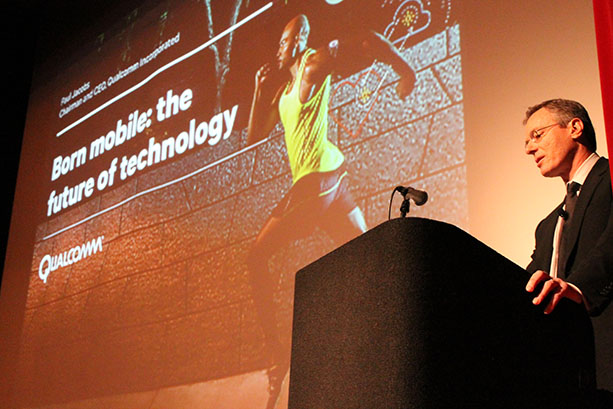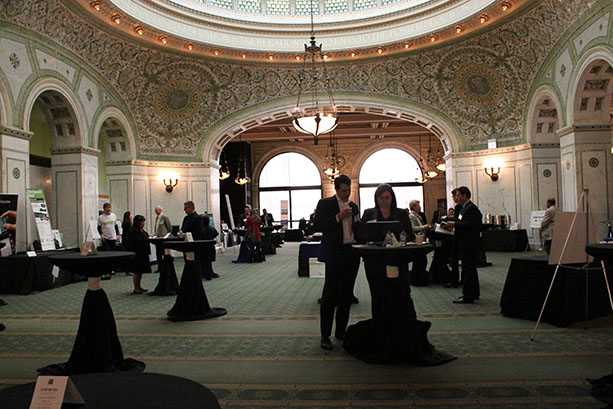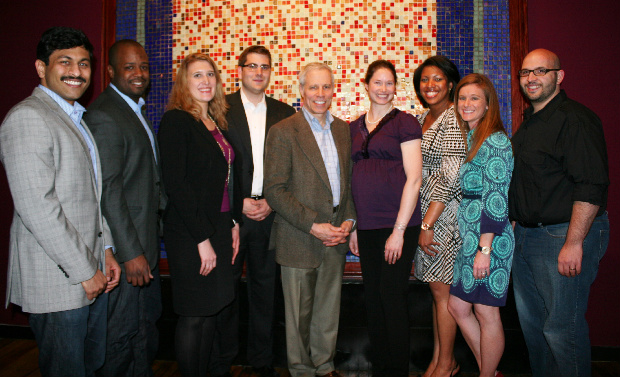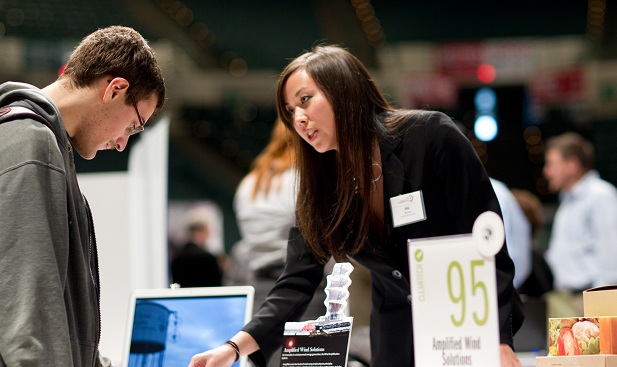Co-authored by: Lauryn Schroeder, Medill News Service

Paul Jacobs, CEO of Qualcomm, won the 2013 Edison Achievement Award, and discussed the capacity of mobile technology to influence innovation.
It starts with something simple. For 12-year-old Quincy Lyons, it started with the first bite of an orange. An orange that he believed to be ripe, only to discover that it was rotten inside. This one experience led him and a team of middle-schoolers from Tuscon’s Sonoran Science Academy to create Non-Toxic, by Toxic, a product that prevents build-up of trapped bacteria in the produce we eat daily. This innovation made the team the youngest finalists at the 26th annual Edison Award in Chicago.
It’s this kind of innovation, in both the young and the experienced, that leads to advancements in technology, science, communication and business, which, in turn, pave the way for a better future.
Traces of innovation can be found everywhere, but it doesn’t come without blood, sweat and tears. Chris Casey, president of Nielsen BASES and Nielsen Consumer Research, attended the event and said innovation came from “a bit of creativity and a whole lot of hard work.” He quoted Edison:
“Genius is 1 percent inspiration and 99 percent perspiration.”
And though it doesn’t come easy, leading American innovators collaborated Thursday evening on how to overcome the struggle of innovation. Paying homage to Thomas Edison, the Edison awards (April 24 – 25) highlighted the accomplishments and journeys of the strongest American innovators across all industries and platforms.
Some of the innovators addressed products we use every day: cell phones, cars and computers. But many foreshadowed developments that will change our future.
Casey said innovation was part of Nielsen’s DNA, and gave insight on what it takes to innovate using examples of Chobani yogurt, Wonderful pistachios and Bud Light Lime, to show how three companies brought creativity to commonplace products.
By elevating the equity of their brands, bringing in an impressive revenue stream and changing the categories of their competition, “the outcome they’ve achieved is every marketer’s dream,” Casey said.
“Innovation is a mix of creativity and science,” he said, providing three steps toward what it takes to be a successful innovator.
Three steps to innovation:
1. Demand-driven insight
Casey said good innovators recognize where demand is and where consumers want change. The problem: Real change never comes from something consumers can tell you about, or else, they would have told you.
Casey quoted Henry Ford during the forum who said, “If you were to ask people what they wanted before the Model T came out they would have said faster horses.”
He used the example of Bud Light Lime, where Budweiser recognized that younger Americans were developing a sweeter palate. Budweiser rode the trend and in turn, developed a sweeter beer. Chobani yogurt also recognized demand in the Greek yogurt, realizing that consumers were willing to compromise “taste and authenticity” – the competitor’s brand – for a better price. Analyze trend and find where there is a real need for change.
2. Unconstrained approach to product development
Innovators must be able to pursue, shape and develop products with little regard to the way things have been done before, Casey said. Most bend themselves to the mainstream and are constrained by their liabilities and existing assets. It’s the “unencumbered nature of start-ups that give them the most dangerous and most important advantage,” Casey said, noting that the more a company grows, the more its existing developments become a constraint.
Casey urged innovators to take on a degree of risk and think beyond the box. “Doing something white or black doesn’t work when the answer is blue,” he said, urging leaders to go one step further in terms of scientific research, creative thinking, and merging the two fearlessly and imaginatively.
3. Leadership
“Innovators should not expect to be thanked until they succeed,” Casey said. Until that happens, everyone will convince them otherwise. This is why a leader’s approach must be unconstrained: Change is hard to welcome. While the rest of the world, and your existing assets, may sway you away from your idea, as a leader you must be strong enough to carry the process through from beginning to end.
“Leadership must believe and must instill belief in everyone,” he said. “Everywhere we look, the winners are always those who believe,” and without pervasive leadership, you won’t reach unmet demand.
People often recognize the final product, but rarely recognize the process of innovation. “People take it for granted,” said Frank Bonafilia, executive director of the Edison Awards.
Furthermore, most recognition of innovation comes from within specific industries, people rarely step outside of the box to see what others are creating. “That’s where we’re different. We collaborate across industries, just like Edison did.”
“People are so focused on who they are and what they do, we help them see something different,” Bonafilia said. The vast range of industries recognized at the event is what made the award ceremony a learning experience, not only looking back on the year’s achievement, but looking forward into spaces that innovation can move.
————————————————————————————-
Award winners and lessons learned
In total, 131 awards were given in 14 categories and 38 sub-categories.
Paul E. Jacobs, CEO of Qualcomm, received the 2013 Edison Achievement Award. He stressed that his success came from three things: innovation, execution and partnership.
Jacobs said his company’s commitment to innovation is in investments in research and development, and the ability to make the cellular device as an open-source tool for innovators to build upon.
“It’s the synergy of interdisciplinary work,” he said, adding that the future must be re-imagined at the intersection of engineering, design and marketing, and the moving pieces coming together.
Jacobs said the real world will have the same characteristics as a web page but technology shouldn’t be created for the sake of technology alone. Instead, it should be a platform for social development and further innovation.
Jacobs imagined a world with technology as an aid to education and healthcare. “You’re always connected to people in your life, not because you always talk to them, but because you always can.”
“You’ll feel the same way about your healthcare professional,” Jacobs said. Teachers, parents, and students will also be able to communicate on a deeper level. He outlined the idea of a “digital sixth-sense” where we will use the phone as an “interface to understand what we can perceive and what we can control,” the ultimate catalyst to interactivity.
Some past winners of the Edison Achievement Award include Apple’s Steve Jobs, Time Warner’s Ted Turner, and Herb Baum of Campbell Soup Co., showing that Jacob’s legacy lands upon many that have formed the innovative environment that exists today.
Cellular capabilities weren’t the only types of technology addressed. Kristian Hammond, chief technology officer of Narrative Science, foreshadowed a form of data aggregation and analysis that is “deeper than human,” he said. Quill by Narrative Science won an award for innovative services, and is changing the way people consume information.
Quill programmatically processes data into human language. Reports are made in the form of news stories and recommendations for business owners. The recommendations may just help one business owner at a time, Hammond said, but “for that one person, this document is going to change their lives.” Hammond’s project shows the place of science in a human world, the ultimate mix of science and art: data and language.
David Fitzgerald, the Director of Channels for North America at Barco, Inc., attended Hammond’s seminar and predicted that the data aggregation could be used for more than just business analysis. Quill has also taken off in an academic platform. It allows high school students to receive their standardized testing scores along with written feedback, which will indicate what areas need improvement.
“With online classes taking over, I think this will allow students to get more feedback on an individual basis,” Fitzgerald said. “Especially for the middle kids that get lost in the crowd.”
Rethink Robotics, by Baxter, was also a Gold award winner in the productivity tools sub-category. Rodney Brooks, founder of Rethink Robotics, imagined a world where robots were more accessible to individuals and companies, carrying qualifications of safety and efficiency rather than pure speed, departing from the traditional industrial norm. Again, giving technology a human element, making robots yield human forms of progress.
Bioprinters for Regenerative Medicine won the “Game Changer” award in science and medicine, showing how research in material science have married technological advancements to healthcare improvements, much as Jacobs had imagined. Even though such foreign materials can seem like a big change to humanity, it is not at all an unnatural movement into the future.
The Nature Conservancy won three awards in total, with two gold awards — one for the Tuungane Project, a conservation and development project based in Tanzania, and one for Nature Works Everywhere, a program teaching how nature works and how it can be conserved. These efforts highlighted not only a large degree of data and research accumulation, but the capacity to transform research into programs that can change environments and educate the public on a mass scale.
————————————————————————————-
Innovation Across Industries
Though technological innovation has transformed the globe, social innovation was the most interesting trend this year, said Bonafilia, the awards executive director. Giving back was not just for the non-profit and philanthropic companies. Through a generous donation, three of the middle-schoolers from Non-Toxic by Toxic were able to attend the event. And Bonafilia said every company in attendance agreed to give back to Chicago area schools through mentorship.
Social Trends
John Hewko, CEO of Rotary International, said companies recognized at the event emphasize “social good that is sustainable and leads to real impact,” as opposed to just “feel-good” returns.
Rather than making a wide range of global efforts at one time, Hewko said Rotary International is focused on deeper, sustainable outcomes, with greater collaboration with the private sector. There was a “realization that both have to collaborate because both have a vested interest in seeing certain issues resolve,” Hewko said. “It’s a win-win for everyone.”
Hewko commended the Nature Conservancy on their strategic planning, saying that the organization’s commitment to strategy, collaboration and partnerships is something to learn from. He also said work done by Narrative Science was applicable to what Rotary does with data collection, and work done by Nielsen could measure impact to humanitarian space, proving that innovation isn’t just at the intersection of science and creativity, but also at the intersection of science and social good.
Collaboration is needed to “bridge the divide” between sectors, he said, adding that interdisciplinary work and placing value on volunteer capital are needed to solve global issues, one step at time.
Transportation Trends
Delphi Automotive was one of the Gold award winners in the transportation sphere due to the creation of the Delphi Connected Car app and coinciding vehicle diagnostics by Delphi, sold through Verizon and launched in March.
Through watching trends in smart phones and cloud services, Craig Tieman, Delphi advanced technology manager and creator of the app, said that he was able to make a universal product to connect smart phones to cars, making an intuitive, user friendly interface mixing GPS, cellular modems and Bluetooth along with other user capabilities.
Tieman said the greatest trend he has seen was a “tremendous electronification” of the industry and was already inspired to create more products that move into the future.
But beyond the bottom line, trends in transportation reveal an industry commitment to consumers and the environment, such as with Boeing’s 787 Dreamliner and Caterpillar’s new hybrid excavators. “People look so much at the dollar sign,” Bonafilia said, but people don’t look enough at the teams and social intent. “We’ve come full circle in recognizing successful products with real impact.”
Consumer Trends
“At the end of the day, innovation is in everything we do,” said Glo Science co-founder Stacey Levine. Glo Science products promote oral health and are known for teeth whitening devices sold in beauty stores such as Sephora. More recently the product has been launched in dental offices and stores highlighting technology, such as Brookstone. “We’ve created our own new category in beauty products: the smile,” said Levine. “Our job is to provide solutions for everyone to have a healthy and beautiful smile.”
Though Glo Science won its award in consumer packages, Levine said the product is geared toward promoting dental health as well. “More people need to know about the Edison awards,” Levine said. “They truly celebrate new innovations…that make life that much better.”
The same goes for technology according to Bonafilia.
“I think there’s technology that complicates life,” Bonafilia said. “But there’s also technology that simplifies complicated business.”
This year’s award winners defined new boundaries of esoteric and technological advancements, but brought an important lesson to all: The best advancements are the ones that are human, and the ones that create opportunity for the future.
Furthermore, award winners and attendees proved innovation comes with interdisciplinary work, and a strong belief in yourself. Casey, quoted Einstein: “Doing the opposite of something that’s wrong isn’t the right thing.”
“Along the way, you’ll be told by everyone to stop or switch direction,” he said. “But in the end your success or failure is determined by leadership…and not being satisfied until you’ve delivered.”










